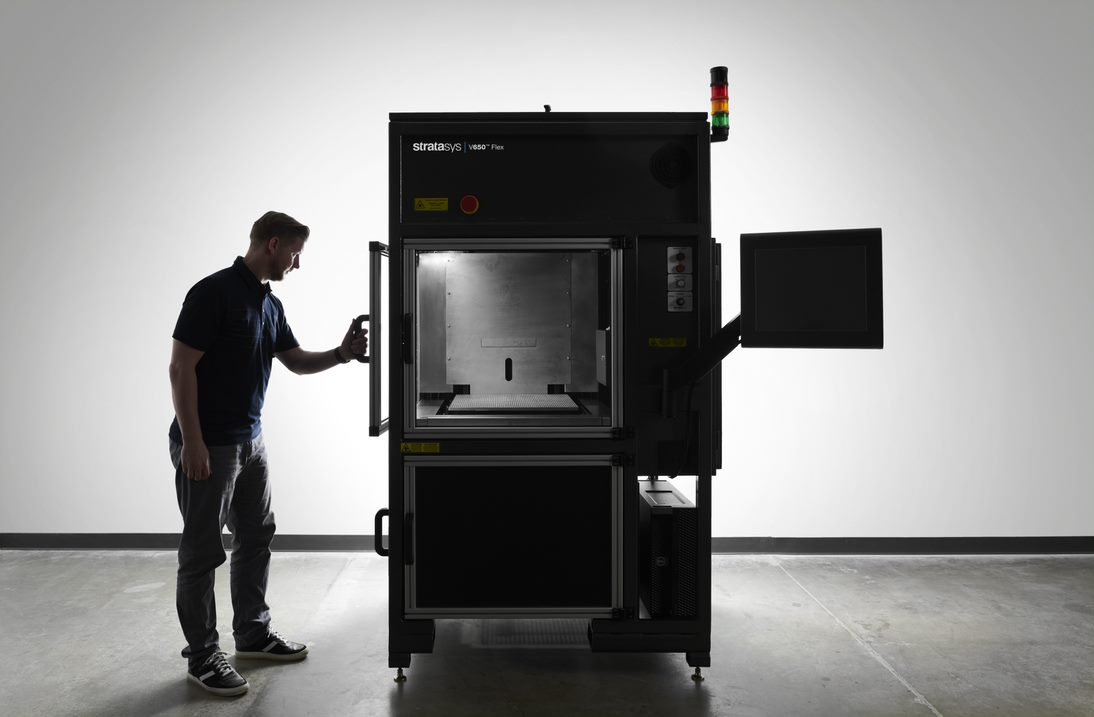![The V650 Flex SLA 3D printer [Image: Stratasys]](https://fabbaloo.com/wp-content/uploads/2020/05/v650_hires_final_img_5eb09a1f9e7ea.jpg)
Stratasys is unveiling two new 3D printers today, stepping deeper into FDM and introducing its first commercial SLA machine.
I spoke to Pat Carey, SVP of Strategic Growth, and Gina Scala, Director of Education, for details behind the new machines.
FDM
![The F120 FDM 3D printer [Image: Stratasys]](https://fabbaloo.com/wp-content/uploads/2020/05/F120_hires_FINAL_img_5eb09a2022f3d.jpg)
Last year at SOLIDWORKS World, Stratasys introduced its F123 line of 3D printers. That line is expanding now with the F120.
Scala explained that the new machine is an industrial-grade 3D printer designed for accuracy and repeatability with the ability to make complex, functional parts out of ABS, ASA, or SR30 materials with soluble supports.
“The first thing that jumps out at you is that the F120 has two filament boxes underneath the printer. They are large boxes; each has three times the amount of material that a typical F123 cartridge has. That allows for up to 250 hours of uninterrupted 3D printing, allowing for less experienced operators to switch filament less,” she said.
The F120 was designed for ease of use for both experienced and newer operators. It’s an entry-level industrial machine that can come into play for designers, engineers, and educators who don’t want “to wait in line at their RP lab or send things out.” At $11,999, the price doesn’t necessarily seem ‘entry-level’ at a glance, though for an industrial machine offering high quality it’s pretty accessible. Deliveries are set to begin in July.
For schools, particularly those training the next generations of engineers and designers, the F120 is designed to be a good way to gain hands-on experience.
“These folks want to be using the technology the industry is using so their students are workforce-ready to not only survive, but to thrive in today’s fast-paced product design, engineering, and design world,” Scala added.
While many 3D printers and materials showing up on the market today are application-specific, the F120 is not. This, Scala underscored, is a tool that is capable of prototyping “up to full-on end-use parts.” The Stratasys team designed it in response to customer demand for productivity tools rather than application-specific equipment.
SLA
Next, Pat Carey said, “Let’s talk about something completely different.”
SLA is a mainstay in 3D printing as the first technology to be commercialized. Stratasys itself has been 3D printing with SLA internally for 28 years.
“We’ve been making our own SLA machines for ourselves for a number of years,” Carey told me. “We’ve sold a few to customers and saw the demand, and now we’re commercializing and plugging SLA in to the Stratasys infrastructure.”
So today we meet the V650 Flex SLA 3D printer.
It’s already had a runtime of more than 75,000 hours, producing more than 150,000 parts. With a 20” x 20” x 23” vat capacity, the machine is set for pretty big things.
One major point for the V650 that marks a big change for Stratasys: it’s an open platform.
“This is the number one request we get from customers, so materials aren’t controlled,” Carey continued. “They want a high level of configurability, to tune in based on whatever resin they’re using… We’re changing our materials strategy.”
Stratasys has partnered with DSM — another team I spoke to recently, with more details to come soon from their perspective.
With DSM, Stratasys is kicking off the V650 with four verified Somos resins: Element, NeXt, PerFORM, Watershed XC 11122.
“But we won’t require people to print with only DSM resins,” Carey said. “We expect most users will already be experienced with SLA and have their resins of choice. The whole focus on this is that it’s an open, configurable, large vat system.”
The target user for the V650 is on the higher end of the market, primarily service bureaus and large enterprises.
Customers in these areas have been requesting this machine for some time now, Carey added: “They keep calling and saying, ‘Pat, we know you have this printer.’” So now, here it is.
SLA may seem like a surprise from Stratasys, which has been focused so thoroughly on its FDM and PolyJet lines with most recent introductions.
“What we’ve seen with PolyJet and the latest evolutions there is the ability to print an amazing amount of colors at a pixel level. The continuous success of PolyJet is really around color, translucency, multi-material capabilities, really getting away from a single-material print. There’s still a large opportunity for single-material print, though, especially in investment casting and injection molding. This created an opportunity for us to say we know this technology very well, we use this technology in our service bureau, let’s bring this product to market,” Carey told me.
The company is not announcing pricing for the time being, but will be taking orders this week with delivery starting in Q3.
And now that the V650 has introduced an open materials platform for a Stratasys machine, can we expect to see more of that?
“I would speculate there would be something to be considered there, but there’s nothing to announce yet,” Carey told me. “It gives us something to talk about later.”
We’ll have more detail from DSM about their involvement with Stratasys and the 3D printing industry soon.
Via Stratasys: V650 Flex and F120











The debate over use of proprietary or open materials ecosystems is becoming a big topic in 3D printing.